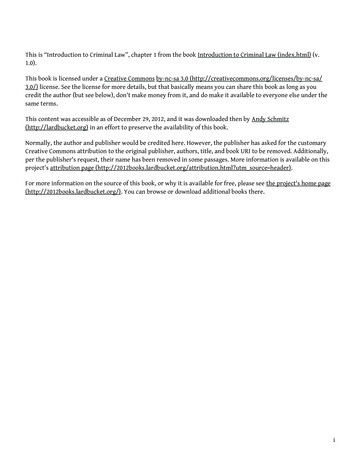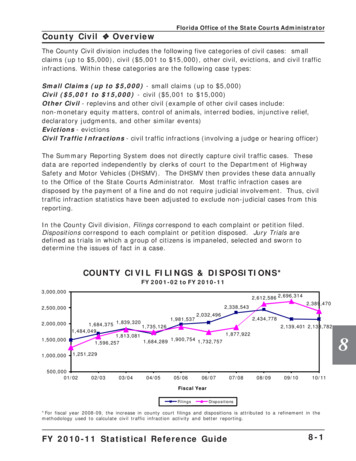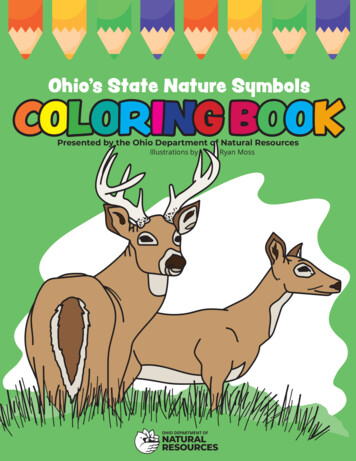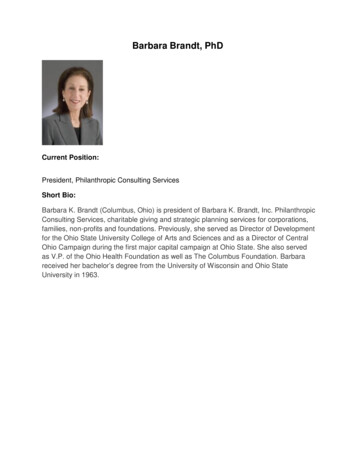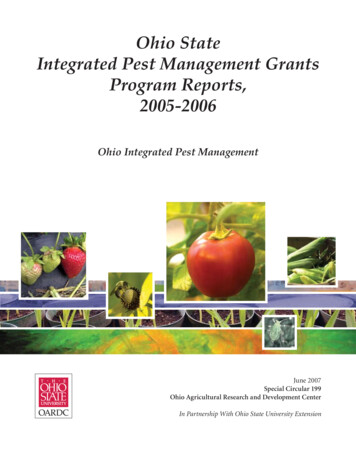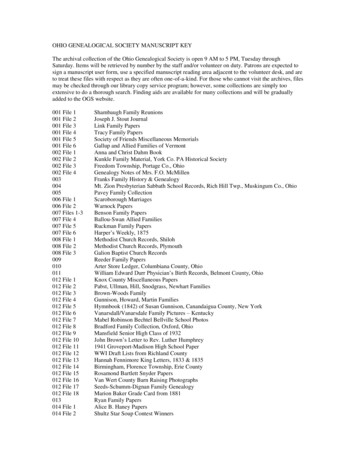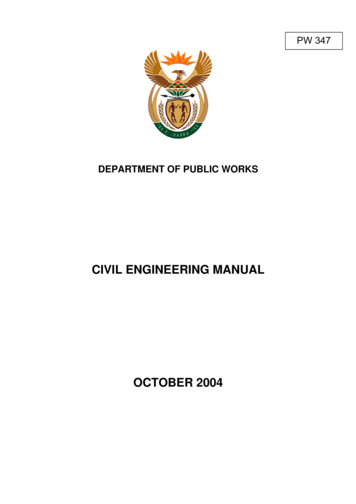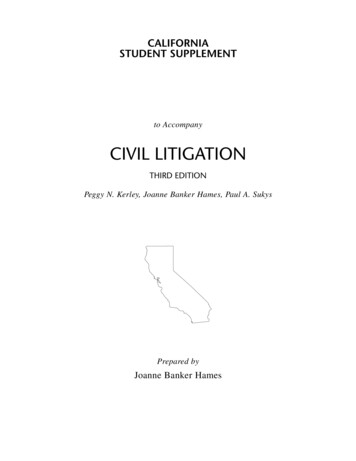
Transcription
CALIFORNIASTUDENT SUPPLEMENTto AccompanyCIVIL LITIGATIONTHIRD EDITIONPeggy N. Kerley, Joanne Banker Hames, Paul A. SukysPrepared byJoanne Banker Hames
CONTENTSPART IINTRODUCTION TO CIVIL LITIGATION FOR THE PARALEGALChapter 1Litigation and the Paralegal . 1Addenda . 2Chapter 2The Courts and Jurisdiction . 3PART IIINITIATING LITIGATIONChapter 3Preliminary Considerations . 6Chapter 4Investigation and Evidence . 9Chapter 5The Initial Pleadings . 11Chapter 6Responses to the Initial Pleading . 26Chapter 7Motion Practice. 41PART IIIDISCOVERYChapter 8Overview of the Discovery Process . 47Chapter 8aExchange of Information Concerning Expert Witnesses . 52Chapter 9Depositions . 56Chapter 10Interrogatories . 65Chapter 11Physical and Mental Examinations. 77Chapter 12Request For Documents . 79Addendum . 82Chapter 13Request for Admissions . 83Addendum . 85PART IVPRETRIAL, TRIAL, AND POSTTRIALChapter 14Settlements, Dismissals, and Alternative Dispute Resolution . 88Chapter 15Trial Techniques . 92Chapter 16Posttrial Practice . 95ii
PART IINTRODUCTION TO CIVIL LITIGATION FORTHE PARALEGALCHAPTER 1LITIGATION AND THE PARALEGALKEY POINTS Civil Litigation in California State Courts is regulated by:California Code of Civil ProcedureCalifornia Rules of CourtLocal Rules of CourtCalifornia Case Law The Judicial Council adopts rules and approves forms for litigation practice in California. Bookmark these cites. You will refer to them often:California CodeCalifornia Rules of CourtCalifornia Codes, CasesJudicial Council FormsRecent California .gov/forms/www.courtinfo.ca.gov/opinions/WHAT CIVIL LITIGATION ISCases of Limited JurisdictionLawsuits where the plaintiff requests less than 25,000in damages are governed by special code provisions knownas Economic Litigation for Limited Civil Cases (found insections 90–100 of the California Code of Civil Procedure).These rules are intended to simplify litigation proceduresin small cases. Although these sections do limit discoverythey do not substantially alter the litigation process.The basic litigation process in the federal and state courtsystems is similar. Nevertheless, many differences betweenthe two systems do exist. Time requirements are often notthe same, the format of documents may vary and, most importantly, a different set of laws control. In spite of the differences, the job of the attorney and the paralegal in thelitigation process remains the same.DIFFERENT TYPES OF LAWSUITSComplex Civil LitigationComplex civil cases often present difficult problems forthe court. Recently, pilot programs in several counties havebeen created to deal with these cases effectively, by providing the judges with special training and resources. A complex civil case is defined by California Rule of Court, Rule1800 as “an action that requires exceptional judicial management to avoid placing unnecessary burdens on the courtor the litigants and to expedite the case, keep costs reasonable, and promote effective decision-making by the court,the parties, and counsel.” These include such cases as antitrust, securities claims, environmental and mass torts, andclass actions.Different types of civil lawsuits exist in California justas they do in all jurisdictions. Some of these differencesresult in important changes in the litigation process, especially in family law cases, unlawful detainer (eviction actions), and cases where the plaintiff is asking for less than 25,000.Family Law CasesFamily law cases, although civil in nature, are governedby special rules found in the Family Code. Although thegeneral litigation process is similar, special forms must beused for pleadings.ALTERNATIVES AND LIMITATIONS TOLITIGATIONUnlawful Detainer ActionsUnlawful detainer actions, while regulated by the general rules of civil litigation, have much shorter time requirementsfor the various aspects of litigation.In California alternatives and limitations to the litigationprocess are growing in popularity. Judicial arbitration, aspecial type of nonbinding arbitration, has been in effectfor many years. Judicial arbitration is part of the litigation1
SOURCES OF LAWprocess. The California Code of Civil Procedure (referredto as CCP) provides that in superior courts having ten ormore judges (or eighteen judges, if the county has no municipal court), cases where the damages do not exceed 50,000can be ordered to a nonbinding arbitration hearing. Judicialarbitration is optional in other courts. If any party does notaccept the award, then the case goes to trial. A party whodoes not agree with an arbitration award must act promptlyto reject it, however. A party rejects an arbitration award byfiling a request for trial de novo with the court in which theaction is pending within thirty days. (See CCP §§ 1141.10et seq.)The California courts have been encouraged to developother methods of alternative dispute resolution (ADR), inparticular, mediation. CCP 1775–1775.16 sets up a mediation pilot project in Los Angeles county and in any othercounty choosing to participate. Rules 32 and 32.5 of theAppendix to the California Rules of Court also encouragesestablishment of ADR procedures. These rules also requirethe court to provide the parties with information about ADR.Within the state, several ADR providers have been established. These providers consist of retired judges and experienced attorneys who offer their services as arbitrators,mediators, discovery referees, and private judges.Along with the encouragement of ADR, the Californialegislature had also enacted laws that limit the litigation process,especially in the area of medical malpractice. For example,for medical malpractice cases various statutes limit the amountof noneconomic damages (usually damages for pain andsuffering) that can be recovered, limit the amount of attorney fees that can be charged, and limit the request for punitive damages.CHAPTER 1The law of California civil litigation is found in the California Constitution, California cases, California codes (inparticular, the California Code of Civil Procedure), the California Rules of Court and various local rules of court. Mostcourts have posted their local rules of court on the Internet.An index to local rules of state and federal courts is foundat www.nocall.org/rules.html. A second directory of localrules of court can be found at www.netlawlibraries.com(Although this is a fee-based site, users can access someservices free, including the directory to local rules of court.)Local rules of court can also usually be found on any court’shomepage. A directory of some state court homepages (trial,appellate, and Supreme Courts) can be found at numeroussites s secondary sources exist for litigation practicein the California courts. Several works are published by theWest Group. Check their website for a complete listing:store.westgroup.com. A second popular collection of practice books are those published by Continuing Education ofthe Bar (CEB). Numerous pleading forms are also found inthe California Forms of Pleading and Practice published byMatthew Bender.Professional OrganizationsMany counties in California have paralegal associations.Many of these belong to the California Alliance of ParalegalAssociations (CAPA). Their website is www.caparalegal.org.This site links to many local associations.ADDENDATHE JUDICIAL COUNCIL AND CALIFORNIACIVIL LITIGATIONDelay Reduction Act, more commonly referred to as fasttrack. Generally, fast track requires closer judicial supervision of cases, and results in many of the time limits beingshortened. At first this was a pilot project and was adoptedonly in selected counties. It is now in effect throughout thestate. Fast track rules require parties to act promptly in servingand responding to pleadings and severely limit the right ofattorneys to grant extensions or continuances to one another.Fast track procedures are found in the California Government Code §§ 68603 et seq., California Rules of Court, Rules2101–2106 and various local rules of court. The rules aresometimes referred to as “Differential Case Management Rules.”The California Government Code sets certain minimum timelimits that must be allowed for serving and responding topleadings, but within those limits, each county is allowedto proscribe time requirements within the county. As a Californialitigation paralegal, you must be aware of any local rulesregarding fast track. Important attention must be paid to timelimits.The Judicial Council in California is a group of judges,attorneys, and legislative representatives. One of the important functions of this group is to adopt rules for practiceand procedures in the California courts. The Judicial Council has also adopted and approved various standard legalforms to be used in the courts. Some of the Judicial Councilforms are mandatory, while others are optional. Forms thatare mandatory are “adopted,” while optional forms are “approved.” These words appear at the bottom of each JudicialCouncil form. Specific Judicial Council forms will be referred to in subsequent chapters. The Judicial Council websitecan be found at www.courtinfo.ca.gov/courtadmin/jc/.THE TRIAL DELAY REDUCTION ACTIn an effort to reduce the delay in resolving civil cases,in 1986 the California legislature enacted the Trial Court2
CHAPTER 2THE COURTS AND JURISDICTIONKEY POINTS The California court system is patterned after the federal court system. Most California trial courts are known as superior court. Smaller civil cases (under 25,000) are referred to as limited civil cases. Bookmark these websites, as they contain useful information:California Court InformationDirectory to California htmlUNITED STATES DISTRICT COURTSsuperior and municipal courts into one court system. Theunified courts would all be superior courts. To date, mostcounties in the state have unified. In the few counties thathave not voted to unify, the established superior/municipalcourt system remains. The majority of counties, however,have seen considerable change. All trial courts are superiorcourts and all judges are superior court judges.In spite of the unification, the courts still recognize thedifferences between cases that were at one time in the jurisdiction of municipal courts and those that were within thejurisdiction of superior courts. Cases (both cases at law andcases in equity) that previously would have been filed inmunicipal court are now referred to as limited civil cases.Sections 85–100 of the Code of Civil Procedure control.The major differences in these cases are a reduced filingfee and more limited discovery. A complete list of all casesdesignated as limited civil cases is found in sections 85, 86,and 86.1. The following is a list of some of the more common equitable cases now referred to as limited civil cases:California is divided into four districts for the federaltrial ernDistrictSouthernDistrictLocationSan FranciscoWebsitewww.cand.uscourts.gov/Los courts.gov/San Diegowww.casd.uscourts.gov/UNITED STATES COURTS OF APPEALSCalifornia is in the Ninth Circuit. The court is located inSan Francisco. Its website is www.ca9.uscourts.gov/.STATE COURT SYSTEMS1. Actions to dissolve a partnership where the total assets of the business do not exceed 25,000;2. Actions of interpleader where the mount of money orthe value of the property involved does not exceed 25,000(see Chapter 5 for discussion of interpleader);3. Actions to cancel or rescind a contract when this reliefis sought in connection with an action to recover moneyor property not exceeding 25,000 in value;4. Unlawful detainer (eviction) actions where the totaldamage claimed is 25,000 or less;5. Actions to enforce or foreclose liens on personal property where the amount of the lien is 25,000 or less;6. Actions to enforce mechanics liens (liens against realproperty for work done on the property) where the amountof the lien is 25,000 or less;7. Actions for declaratory relief when brought as a crosscomplaint in an action otherwise within the jurisdiction of the municipal court;8. Actions for temporary restraining orders, preliminaryinjunctions, accountings or appointment of receiverswhere necessary in an action pending in the municipalcourt.The California state court structure is patterned after thefederal system and contains trial courts, courts of appealand one state supreme court.Trial CourtsUntil June 1998, the California court system consistedof two different types of trial courts, superior courts andmunicipal courts. In actions for money damages (actions atlaw), the superior court had jurisdiction to hear cases wherethe amount demanded, exclusive of interest and costs, exceeded 25,000. The equitable jurisdiction of the superiorcourt extended to all cases except those in which equitablejurisdiction had been specifically conferred upon the municipal court. The municipal courts had jurisdiction over actionsat law where the amount demanded was 25,000 or less andin certain specified equitable cases.Trial Court UnificationIn response to legislative action and voter approval, afterJune 1998, each county was given the option of unifying its3
In addition to original jurisdiction, the superior court alsomaintains an appellate division that hears appeals from either municipal court cases or cases of limited civil jurisdiction. In exercising appellate jurisdiction, three superior courtjudges review a case as a panel, in the same way that anycourt of appeals functions.that primarily exercises appellate jurisdiction. Also like theUnited States Supreme Court, the exercise of that jurisdiction is usually discretionary. To request a hearing in a civilcase before the state Supreme Court, a party files a petitionfor review rather than a petition for a writ of certiorari (Rule28, Calif. Rules of Court).Small Claims CourtA small claims division exists in all municipal courts andin all superior courts in counties not having municipal courts.In general, small claims courts have jurisdiction to hear caseswhere the amount in controversy is less than 5000 (CCP§116.220). In most cases, parties in small claims court proceedings are not allowed to be represented by attorneys. Asa result, the procedures are kept fairly simple and only thedefendant is allowed to appeal. Such an appeal is filed inthe superior court and results in a retrial of the case. Partiesare allowed to be represented by attorneys in a small claimscourt appeal.JURISDICTIONCourts of AppealCalifornia is divided into six appellate districts. The largerdistricts are further divided into divisions. Like their federal counterpart, these courts are primarily courts of review.They hear appeals from cases originally tried in the superior court. Cases are heard by a three-judge panel and themajority decision prevails.The following is a list of the counties within each of thesix districts:Challenging Subject Matter JurisdictionSubject matter jurisdiction in California is often challenged by filing a special pleading known as a demurrer inresponse to the complaint (CCP § 430.10). Lack of subjectmatter jurisdiction can also be raised in the answer as anaffirmative defense.First AppellateDistrictSubject Matter JurisdictionIn counties where trial courts have unified, the superiorcourt has subject jurisdiction over all civil cases not withinthe exclusive jurisdiction of federal court. However, smallercases are identified as limited civil cases. In the few counties where trial court unification has not occurred, the superior court has subject matter jurisdiction over civil cases wherethe demand exceeds 25,000 and over equitable cases wherethe code has not specifically conferred jurisdiction in themunicipal court.Personal Jurisdiction over DefendantPersonal jurisdiction over the defendant in an action iscontrolled by CCP § 410.10:San Francisco, Marin, Sonoma, Napa,Solano, Lake, Mendocino, Humboldt,Del Norte, Contra Costa, Alameda,and San MateoSecond AppellateDistrictSan Luis Obispo, Santa Barbara,Ventura, and Los AngelesThird AppellateDistrictSiskiyou, Modoc, Trinity, Shasta,Lassen, Tehama, Plumas, Colusa,Glenn, Butte, Sierra, Sutter, Yuba,Nevada, Yolo, Placer, Sacramento,El Dorado, San Joaquin, Amador,Calaveras, Alpine, and MonoFourth AppellateDistrictInyo, San Bernadino, Riverside,Orange, San Diego, and ImperialFifth AppellateDistrictStanislaus, Tuolumne, Merced,Mariposa, Madera, Fresno, Kings,Tulare, and KernSixth AppellateDistrictSanta Clara, Santa Cruz, Monterey,and San BenitoA court of this state may exercise jurisdiction on any basis notinconsistent with the Constitution of this state or of the UnitedStates.Thus, if a defendant is domiciled within the state or hassufficient contacts with the state to satisfy constitutional dueprocess requirements, the state courts can exercise personaljurisdiction over that defendant. Whether a defendant hassufficient contacts with the state is a question of fact to bedetermined in each case. Case law is important in this determination.NoticeThe exercise of personal jurisdiction over a defendant isdependent on proper notice or service of process. In California, service of process is described in sections 413.10–417.40 of the Code of Civil Procedure. Service of processis discussed in more detail in Chapter 5.Challenging Personal JurisdictionIn California, personal jurisdiction must be challengedby a special appearance, that is an appearance made for thesole purpose of challenging the jurisdiction. A motion toState Supreme CourtCalifornia has one state Supreme Court consisting of sevenjustices. Like the United States Supreme Court, it is a court4
quash service of the summons is the most common way ofdoing this (CCP § 418.10). A defendant who makes a general appearance by filing an answer or a demurrer waivesany defect in the exercise of personal jurisdiction by thecourt and thereby confers personal jurisdiction on the court.foreclosure of a lien on real property, the county where theproperty is located is usually the county of proper venue(CCP § 392).Changing VenueA motion for change of venue in a California action isgoverned by sections 396b and 397 of the Code of CivilProcedure. The grounds for such a motion in general civilcases are:VENUEState Court VenueVenue in state court actions is generally covered in sections 392–402 of the Code of Civil Procedure. Any countyor judicial district in which any of the defendants reside atthe commencement of the action is usually a place of propervenue. If the action is for damages for personal injury ordeath, the action can also be maintained in the county inwhich the injury occurred. Contract disputes can usually bemaintained in the county where the contract is to be performed, in the county in which the contract was entered into,or in the county in which the defendant resides at the commencement of the action (CCP § 395). If the action is oneregarding title to real property, recovery of real property, or1 The court designated in the complaint is not a propercourt;2. An impartial jury cannot be had in the county in whichthe action was originally filed;3. Convenience of witnesses or interests of justice;4. No judge of the court is qualified to hear the case.If the motion is granted, the case will be transferred toanother court of proper jurisdiction (CCP § 398). The codealso requires that certain costs and fees be paid in connection with the transfer (CCP §§ 396b and 399).5
PART II INITIATING LITIGATIONCHAPTER 3PRELIMINARY CONSIDERATIONSKEY POINTS Statutes of limitations are found in CCP §§ 312–365. Claim statutes exist when suing public agencies and estates. Rules of Professional Conduct establish ethical standards for California attorneys. Bookmark this important site:California State Bar Assoc.www.calbar.orgDETERMINING THE EXISTENCE OF ACAUSE OF ACTIONSpecial rules also exist for civil actions based on sexualabuse of minors (CCP § 340.1). Suit must be filed withineight years of the date plaintiff attains majority or withinthree years of the date plaintiff discovers or should havediscovered that a psychological injury was the result of abuse,whichever time is later.California requires that the complaint contain facts whichsupport each element of a cause of action. Identifying thevarious causes of action which might apply in a case is thereforecritical.TIME LIMITATIONSTolling the Statute of LimitationsGenerally, statutes of limitation are tolled when a personis a minor or is incompetent. However, this is not the case ifthe action is against a public entity or employee for a casein which a claim must be made. (CCP § 352) Special rulesalso apply to malpractice cases. Filing deadlines are tolledin medical or legal malpractice cases under a number of circumstances, including concealment of the wrongdoing orfraud. Medical malpractice also has special rules relating tominors (CCP § 352):Statute of LimitationsStatutes of limitations for various actions in Californiaare found in the Code of Civil Procedure, sections 312–365.Some of the more common time limitations for commencing a civil action are:One yearTwo yearsFour yearsActions for personal injuries or deathresulting from wrongful act or neglect ofanother; actions for libel, slander, assault,battery, or false imprisonmentActions based on an oral contractActions based on a written contractActions by a minor shall be commenced within three years fromthe date of the alleged wrongful act except that actions by aminor under the full age of six years shall be commenced withinthree years or prior to his eighth birthday whichever provides alonger period.Additionally, California has date of discovery type statutes for professional malpractice and fraud:Claim Statutes—Public AgenciesThe procedures for filing a claim and a lawsuit against astate or local public agency in California are found in theGovernment Code starting with section 900. Prior to filingcertain types of lawsuits, including those for money damages, a written claim must be submitted to the public agency(Govt. Code § 945.4). A claim relating to a cause of actionfor death or injury to person or property must be presentedto the board or governing body of the public agency withinsix months of the date of injury (Govt. Code § 911.2). Otherclaims must be presented within one year of the accrual ofthe cause of action. Government Code Section 910 outlinesthe requirements of the claim. It must contain the followinginformation:Medical MalpracticeThree years from date of injury or one year from date ofdiscovery, whichever is first.Legal MalpracticeFour years from date of wrongdoing, or one year fromdate of discovery, whichever occurs first.Asbestos ExposureOne year from date of discovery of disability or death, orone year after suffering disability or death, whichever is later.FraudThree years from date of discovery.6
of date the representative was appointed or within thirty daysafter notice to creditors has been given, which is later. Procedures for filing late claims are found in Probate Code section9103. If a claim is rejected, the claimant has three monthsafter that time to file a lawsuit.The code further provides that should a defendant in alawsuit die during the pendency of the action, the lawsuitmust be suspended and a claim presented to the representative. If the claim is rejected, the action can proceed in court(Prob. Code § 9370).Some circumstances do exist in which claim requirementsdo not exist (Prob. Code §§ 9390–9392). For example, claimrequirements against a decedent do not apply if the decedent was insured for the claim and the amount of the claimdoes not exceed the policy limits (Prob. Code § 9390).1. Name and address of the claimant;2. Address to which the person presenting the claim desires notices to be sent;3. Date, place and other circumstances of the occurrenceor transaction that gave rise to the claim;4. General description of the indebtedness, obligation, injuryor damage sustained;5. Name of any public employee who caused the injury,if known;6. Amount claimed if it totals less than 10,000; if morethan 10,000, then the claim should indicate whetherit would be a limited civil case.Many agencies have their own claim form which is provided on request. Once the claim has been submitted, thepublic agency has forty-five days to act on the claim (Govt.Code § 911.6). If the agency denies the claim and gives writtennotice of this to the claimant, the claimant has six monthsto file a lawsuit (Govt. Code § 945.6). If the agency fails togive notice of its action within forty-five days, the claimantcan treat the claim as being denied and file a lawsuit. Insuch a case, however, the six-month time limit does not apply and the plaintiff has two years from the accrual of thecause of action to file a lawsuit (Govt. Code § 925.6). Nolawsuit can be filed until the forty-five days has lapsed. Thesetime limits replace the normal statute of limitations for anycase. When a lawsuit is filed, compliance with this sectionshould be alleged. It is common to attach a copy of the letter denying the claim to the complaint itself.Should a plaintiff fail to submit a timely claim, section911.4 of the Government Code allows the claimant to petition the public agency and request that he or she be allowedto file a late claim. This application must be filed withinone year of the date the cause of action arises. The boardshould grant this petition if the person injured was a minoror incapacitated before the expiration of the time in whichto file a claim. The petition should likewise be granted ifthe failure to file the claim was due to mistake, inadvertence, surprise, or excusable neglect (Govt. Code § 911.6).If the petition is granted, a claim is filed and the case proceeds as if the claim had been filed in a timely fashion. Ifthe petition to file a late claim is denied, then the claimantmust file a petition with the court asking that he or she beallowed to file a complaint even though no claim was everfiled (Govt. Code § 946.6). If the court makes an order allowing the complaint to be filed, it must be done withinthirty days. All claims and notices can be served personallyor sent by mail (Govt. Code §§ 915–915.4)Actions Against Health Care ProfessionalsPrior to filing a lawsuit against a health care professionalfor negligence (medical malpractice), plaintiffs are requiredto give the professional ninety days written notice of theirintention to commence action. The notice should include astatement describing the legal basis of the claim, and thetype of loss sustained including a description of the injuries. A copy of the notice should also be sent to the MedicalBoard of California or Board of Pediatric Medicine, as applicable. No action on this notice need be taken by the healthcare professional and failure to give this notice does notaffect the lawsuit. However, if the plaintiff is representedby an attorney, that attorney is subjected to disciplinary proceedings by the state bar for failing to comply (CCP §§ 364,364.1, and 365).ETHICAL CONSIDERATIONS IN ACCEPTINGA CASEThe conduct of attorneys in California is governed bythe Rules of Professional Conduct adopted by the board ofgovernors of the state bar and approved by the CaliforniaSupreme Court. The California state bar maintains a websiteat www.calbar.org. The California Rules of Professional Conduct, as well as ethics opinions of the state bar, are locatedon this site. Additional rules regarding ethical considerationsare found in the California Business and Professions Code(Sections 6000–6228).ETHICAL CONSIDERATIONS AFTERACCEPTING A CASEClaims Against a DecedentSection 9351 of the California Probate Code provides thatan action may not be commenced against a decedent’s personal representative unless a claim is first filed and is rejected. The claim procedures are found in sections 9100–9256of the California Probate Code. A form for making the claimhas been approved by the Judicial Council. A claim is required to be presented to the representative within four monthsAttorney FeesIn most cases, as long as the attorney fee is not unconscionable, the determination of the attorney fee is negotiable.In some instances, however, attorney fees have been statutorily limited in California, for example
THE PARALEGAL CHAPTER 1 LITIGATION AND THE PARALEGAL Civil Litigation in California State Courts is regulated by: California Code of Civil Procedure California Rules of Court Local Rules of Court California Case Law The Judicial Council adopts rules and approves forms for litigation practice in California. Bookmark these cites. You will refer .
